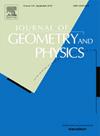Fiber bundle structure in Ashtekar-Barbero-Immirzi formulation of General Relativity
IF 1.2
3区 数学
Q1 MATHEMATICS
引用次数: 0
Abstract
We aim to provide a rigorous geometric framework for the Ashtekar-Barbero-Immirzi formulation of General Relativity. As the starting point of this formulation consists in recasting General Relativity as an gauge theory, it naturally lends itself to interpretation within the theory of principal bundles. The foundation of our framework is the spin structure, which connects the principal -bundle construction with the Riemannian framework. The existence of the spin structure enlightens the geometric properties of the Ashtekar-Barbero-Immirzi-Sen connection and the topological characteristics of the manifold. Within this framework, we are able to express the constraints of the physical theory in a coordinate-free way, using vector-valued forms that acquire a clear geometric interpretation.
Using these geometric concepts, we analyze the phase space of the theory and discuss the implementation of symmetries through the automorphism group of the principal -bundle. In particular, we demonstrate that the description of the kinematical constraints as vector-valued forms provides a natural implementation as momentum maps for the automorphism group action.
广义相对论Ashtekar-Barbero-Immirzi公式中的纤维束结构
我们的目标是为广义相对论的Ashtekar-Barbero-Immirzi公式提供一个严格的几何框架。由于这一表述的出发点在于将广义相对论重新塑造为SU(2)规范理论,因此它自然适合在主束理论中进行解释。我们的框架的基础是自旋结构,它连接了主SU(2)-束结构和黎曼框架。自旋结构的存在启发了Ashtekar-Barbero-Immirzi-Sen连接的几何性质和流形的拓扑特征。在这个框架内,我们能够以无坐标的方式表达物理理论的约束,使用矢量值形式获得清晰的几何解释。利用这些几何概念,我们分析了理论的相空间,并讨论了通过主SU(2)-束的自同构群实现对称。特别地,我们证明了将运动学约束描述为向量值形式为自同构群作用提供了一种自然的动量映射实现。
本文章由计算机程序翻译,如有差异,请以英文原文为准。
求助全文
约1分钟内获得全文
求助全文
来源期刊

Journal of Geometry and Physics
物理-物理:数学物理
CiteScore
2.90
自引率
6.70%
发文量
205
审稿时长
64 days
期刊介绍:
The Journal of Geometry and Physics is an International Journal in Mathematical Physics. The Journal stimulates the interaction between geometry and physics by publishing primary research, feature and review articles which are of common interest to practitioners in both fields.
The Journal of Geometry and Physics now also accepts Letters, allowing for rapid dissemination of outstanding results in the field of geometry and physics. Letters should not exceed a maximum of five printed journal pages (or contain a maximum of 5000 words) and should contain novel, cutting edge results that are of broad interest to the mathematical physics community. Only Letters which are expected to make a significant addition to the literature in the field will be considered.
The Journal covers the following areas of research:
Methods of:
• Algebraic and Differential Topology
• Algebraic Geometry
• Real and Complex Differential Geometry
• Riemannian Manifolds
• Symplectic Geometry
• Global Analysis, Analysis on Manifolds
• Geometric Theory of Differential Equations
• Geometric Control Theory
• Lie Groups and Lie Algebras
• Supermanifolds and Supergroups
• Discrete Geometry
• Spinors and Twistors
Applications to:
• Strings and Superstrings
• Noncommutative Topology and Geometry
• Quantum Groups
• Geometric Methods in Statistics and Probability
• Geometry Approaches to Thermodynamics
• Classical and Quantum Dynamical Systems
• Classical and Quantum Integrable Systems
• Classical and Quantum Mechanics
• Classical and Quantum Field Theory
• General Relativity
• Quantum Information
• Quantum Gravity
 求助内容:
求助内容: 应助结果提醒方式:
应助结果提醒方式:


